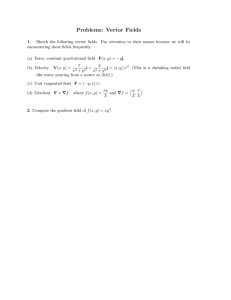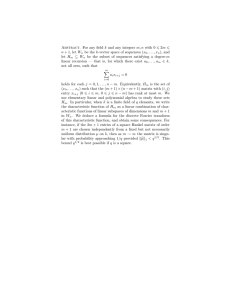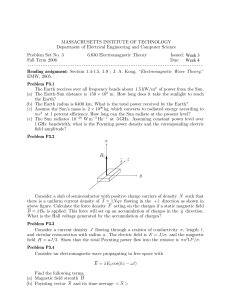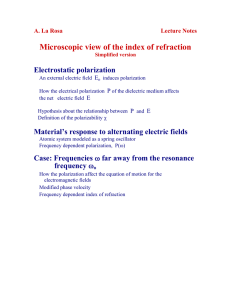Chapter 3 Polarization of a dielectric medium
advertisement
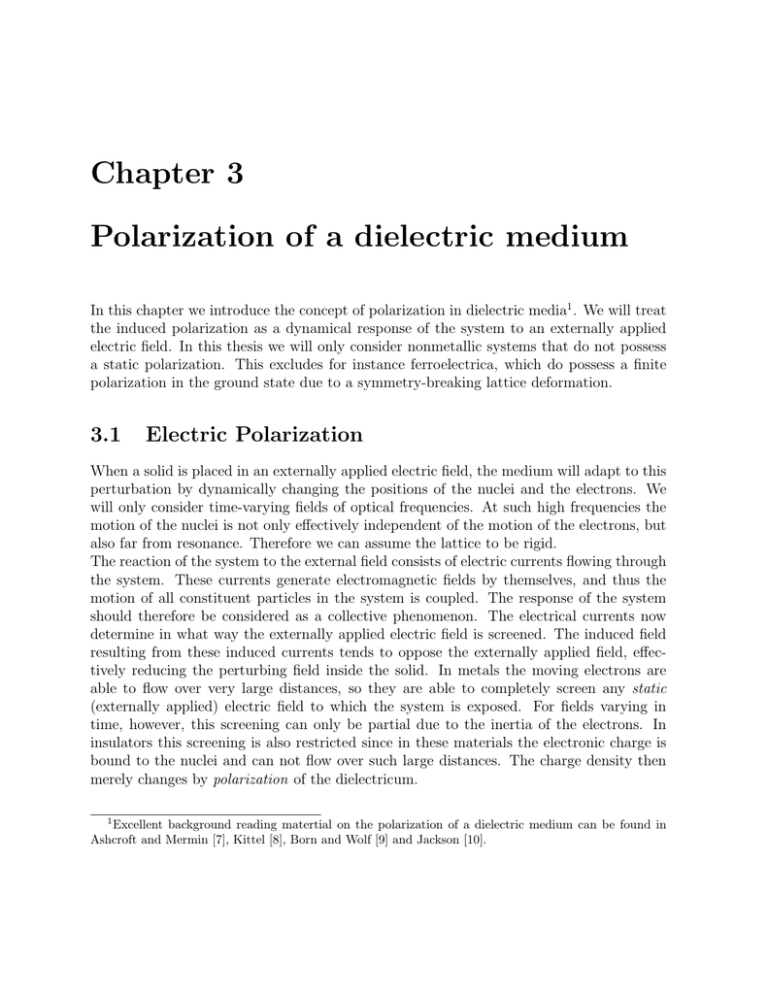
Chapter 3 Polarization of a dielectric medium In this chapter we introduce the concept of polarization in dielectric media1 . We will treat the induced polarization as a dynamical response of the system to an externally applied electric field. In this thesis we will only consider nonmetallic systems that do not possess a static polarization. This excludes for instance ferroelectrica, which do possess a finite polarization in the ground state due to a symmetry-breaking lattice deformation. 3.1 Electric Polarization When a solid is placed in an externally applied electric field, the medium will adapt to this perturbation by dynamically changing the positions of the nuclei and the electrons. We will only consider time-varying fields of optical frequencies. At such high frequencies the motion of the nuclei is not only effectively independent of the motion of the electrons, but also far from resonance. Therefore we can assume the lattice to be rigid. The reaction of the system to the external field consists of electric currents flowing through the system. These currents generate electromagnetic fields by themselves, and thus the motion of all constituent particles in the system is coupled. The response of the system should therefore be considered as a collective phenomenon. The electrical currents now determine in what way the externally applied electric field is screened. The induced field resulting from these induced currents tends to oppose the externally applied field, effectively reducing the perturbing field inside the solid. In metals the moving electrons are able to flow over very large distances, so they are able to completely screen any static (externally applied) electric field to which the system is exposed. For fields varying in time, however, this screening can only be partial due to the inertia of the electrons. In insulators this screening is also restricted since in these materials the electronic charge is bound to the nuclei and can not flow over such large distances. The charge density then merely changes by polarization of the dielectricum. 1 Excellent background reading matertial on the polarization of a dielectric medium can be found in Ashcroft and Mermin [7], Kittel [8], Born and Wolf [9] and Jackson [10]. CHAPTER 3. POLARIZATION OF A DIELECTRIC MEDIUM 18 We define the induced polarization P(r, t) as the time-integral of the induced current, P(r, t) = − t δj(r, t ) dt . (3.1) t0 This completely defines the polarization as a microscopic quantity up to an (irrelevant) constant function of r, being the polarization of the initial state P(r, t0 ). Now by evaluating the divergence of this P(r, t), we immediately get ∇ · P(r, t) = − t t0 ∇ · δj(r, t ) dt = t ∂ρ(r, t ) t0 ∂t dt = δρ(r, t) − δρ(r, t0 ) , (3.2) in which the induced density at t0 , δρ(r, t0 ) is zero by definition. In the second step we have inserted the continuity equation, ∂ ρ(r, t) + ∇ · j(r, t) = 0 . ∂t (3.3) On the other hand we get that the time-derivative of P(r, t) is equal to the induced current density, d P(r, t) = −δj(r, t) . (3.4) dt From the Eqs. 3.2 and 3.4, we immediately see that the polarization P(r, t), uniquely determines both the induced density and the current density. As such, the polarization is just an auxilliary quantity, which does not contain any new information. The above definition for the polarization is very appealing since it is exactly this polarization that is used in the macroscopic Maxwell equations. It is zero outside the dielectricum, where no currents can exist. Moreover, it will turn out that the polarization, as defined in this way, is also very well suited as a basis to define the induced macroscopic polarization. The latter quantity is easily accessible in experiments. We obtain the (induced) macroscopic polarization as the average value of P(r, t) by, 1 1 t P(r , t) dr = − δj(r , t ) dr dt , Pmac (r, t) = |Ωr | Ωr |Ωr | t0 Ωr (3.5) where Ωr is a small region surrounding the point r. The diameter d of this region should be large compared to the lattice parameter a, but small compared to the wavelength of the perturbing field λ, thus λ d a. In this thesis we want to know the induced polarization P(r, t) that occurs as the first-order response of a dielectric medium to an externally applied electric field. We will not treat effects that go beyond linear response. The strength of the induced current, and hence the polarization, depends not only on the external electric field but also on the contributions from the induced sources in the dielectric medium itself. Therefore it is better to describe the polarization as a response of the system, not just to the externally applied electric field, but in addition also to the induced field. This induced field is the result of the induced 3.2. CLAUSIUS-MOSSOTTI RELATION 19 density and current density. We can write the induced polarization as linear response to these fields, according to t P(r, t) = t0 χ(r, t; r , t ) · (Eext (r , t ) + Eind (r , t )) dt dr . (3.6) The response kernel χ(r, t; r , t ) is a material property. This response kernel is a function of r and r , which is in general nonlocal, but has a short range behaviour, i.e., it decays sufficiently fast as a function of |r − r |, and it is causal, i.e., χ vanishes for t > t, which is already made explicit in the time-integral. Furthermore, χ does not depend on the absolute value of t and t , but just on the time-lapse (t − t ). Before we proceed, we define the macroscopic electric field Emac (r, t), in analogy with the macroscopic polarization, as the average of the external plus the induced field, Emac (r, t) = 1 (Eext (r , t) + Eind (r , t)) dr . |Ωr | Ωr (3.7) All contributions to the perturbing field that are due to remote sources, i.e., external sources and remote induced sources, are contained in this macroscopic field. The microscopic part of the perturbing field, which is due to the local structure of the induced sources, is averaged out. This microscopic part has to be proportional to the macroscopic component due to the short range of the response kernel. We can now give the macroscopic polarization as response to the macroscopic field, which is also known as the constitutive equation, t Pmac (r, t) = t0 χe (r, t − t ) · Emac (r, t ) dt . (3.8) For homogeneous systems the χe (r, t − t ) is independent of the position r. Eq. 3.8 then defines the material property χe (t − t ) called the electric susceptibility, from which the macroscopic dielectric function (t − t ) is derived, (t − t ) = 1 + 4πχe (t − t ). 3.2 (3.9) Clausius-Mossotti Relation The relation of the macroscopic polarization to the macroscopic field in a system is often considered in a simple discrete dipole model. Thereby, the system is decomposed into an assembly of localised elements. If the constituent elements are all charge neutral and independently polarizable entities, there is no fundamental problem to derive such a relation. For simplicity we will assume the system to be homogeneous and isotropic, which implies that we can consider the system as a regular (cubic) array of identical dipoles. For each element we can obtain the dipole moment from the polarization P along the following lines. Conventionally the dipole moment of such an entity can be obtained as the first moment of the induced density, (3.10) µ(t) = − r δρ(r, t) dr . V 20 CHAPTER 3. POLARIZATION OF A DIELECTRIC MEDIUM We will now show that this dipole moment is equivalent to the integrated polarization defined in Eq. 3.1. Consider therefore the variation in time of a Cartesian component of this dipole moment ∂ ∂ µx (t) = − x δρ(r, t) dr . (3.11) ∂t ∂t V Inserting the continuity relation (Eq. 3.3) gives ∂ x (∇ · δj(r, t)) dr . µx (t) = ∂t V (3.12) We can now integrate by parts, and use Gauss’ theorem, to arrive at ∂ (∇ · (xδj(r, t)) − (∇x) · δj(r, t)) dr µx (t) = ∂t V = xδj(r, t) · n ds − δjx (r, t) dr . S (3.13) V If the current crossing the surface is zero, then the surface integral in Eq. 3.13 vanishes. This is ensured by the assumption of independently polarizable elements. Therefore the change in the dipole moment becomes directly related to the current flowing in the interior of each element, and we can conclude that the induced dipole moment is given by µ(t) = − t δj(r, t ) dr dt = t0 V P(r, t) dr . (3.14) V We can now relate the macroscopic polarization Pmac (t) to µ(t) by using Eq. 3.5, Pmac (t) = µ(t) . V (3.15) In the sequel we will only consider the static case. The dipole moment µ, is related to the local electric field Eloc (i.e., the local perturbing field acting on each element), by the polarizability α of the element, (3.16) µ = α · Eloc . The local electric field in such an element of the system can be decomposed into a number of contributions, for which the general expression is given by cont discr Eloc = Eext + Emac ind − Enear + Enear . (3.17) The various contributions to Eloc are depicted in Fig. 3.1. In this figure, Eext is the field produced by fixed charges external to the system. Emac ind is conventionally called the depolarization field, i.e., the field of a uniformly polarized medium, or equivalently the field due to the surface charge density n̂ · P, on the boundary of the system, which in the interior of the system tends to oppose the external applied field. We create a cavity in the system by subtracting the contribution of a uniformly polarized sphere. The corresponding field, Econt near , is called the Lorentz cavity field, which is the field from this sphere that can 3.2. CLAUSIUS-MOSSOTTI RELATION 21 E ext mac E ind cont E near discr E near Figure 3.1: Contributions to the local electric field Eloc in an element of the system. It is the sum of the externally applied electric field Eext , and the field due to all the other cont discr elements Emac ind − Enear + Enear of the system. be described by a polarization charge on the inside of the spherical cavity cut out of the system, with the reference element in the center. Finally the contribution Ediscr near is the field produced by the elements inside this cavity. We can now use the Lorentz relation for the local field in an element of the system, Eloc = Eext + Emac ind + 4π Pmac , 3 (3.18) in which we have used that the field inside a uniformly polarized sphere is given by Econt near = −4πPmac /3, and that the contribution of the discrete elements in the cavity vanishes on symmetry grounds [7, 8], Ediscr near = 0. By combining the Eqs. 3.15, 3.16, and 3.18, we can solve for the polarization Pmac Pmac α 4π α 4π = Eext + Emac Emac + Pmac = Pmac ind + V 3 V 3 , (3.19) in this equation we have indentified: Emac = Eext + Emac ind . Simple algebraic manipulations reveal that Pmac = χe Emac , in which χ is given by χe = α/V . 1 − 4πα/3V (3.20) Now by using the definition = 1 + 4πχe , and rearanging Eq. 3.20, we obtain the ClausiusMossotti relation. 4πα −1 = . (3.21) +2 3V We have now related the property of the system to the response properties of the constituent elements. 22 3.3 CHAPTER 3. POLARIZATION OF A DIELECTRIC MEDIUM Polarization in Extended Systems In the previous section we have shown that for a simple discrete dipole model one can derive an expression for the collective response of the total system to a macroscopic field, by only using the intrinsic properties of the constituent elements. The approximations used in that derivation break down as soon as the elements can no longer be considered as independent. In general this is the case, since electrons do not belong to the individual elements of the system. The electron density should be regarded as a continuous function of the position. There is no way to uniquely partition the system into seperate elements and derive the polarization from the dipole moments of the elements. The dipole moment of the density is not a good measure for the polarization because currents can flow across the borders of the elements. From Eq. 3.13, it is clear that the dipole moment in Eq. 3.10 and the polarization as derived from the current density in Eq. 3.1, become different as soon as such currents exist. The polarization in terms of the dipole moment of the elements is ill-defined because it depends on the particular choice how to partition the system. However, the definition in terms of the induced current provides a simple way to obtain a well-defined polarization, which is model independent in the sense that it does not depend on the particular choice for the subdivision of the system into the various elements. Only in the above mentioned extreme Clausius-Mossotti case, in which the system consists of well-separated, independently polarizable, and charge neutral entities, the two definition become equivalent. There is a second, more subtle argument which makes the definition of the polarization in terms of the induced current more attractive, if we want to consider extended systems. The intrinsic charge that piles up at the surface is directly related to the current flowing through the interior of the system, and therefore it is not necessary to consider the surface of the system explicitly. The polarization is defined as being locally dependent on the induced current and has a unique value at every position in the system. The induced dipole moment is connected to a volume element of the system and is in general not model independent. More over its value depends on the induced density in a very nonlocal way. If we consider the dipole moment of the complete sample, the two alternative descriptions, based either on the dipole strength of the charge distribution of the system, including the surface, or on the total integrated current, are equivalent (Eq. 3.14), owing to the continuity equation. In the following chapter we will treat the extended system in the thermodynamic limit of infinite system size. In this limit the system is modeled using periodic boundary conditions and consequently the knowledge of the surface is lost in the process. The charge and current distributions then become disconnected and carry quite distinct pieces of information, though the variations of these distributions remain connected by the continuity equation. In periodic systems, polarization is therefore a property of the current and not of the charge density.

